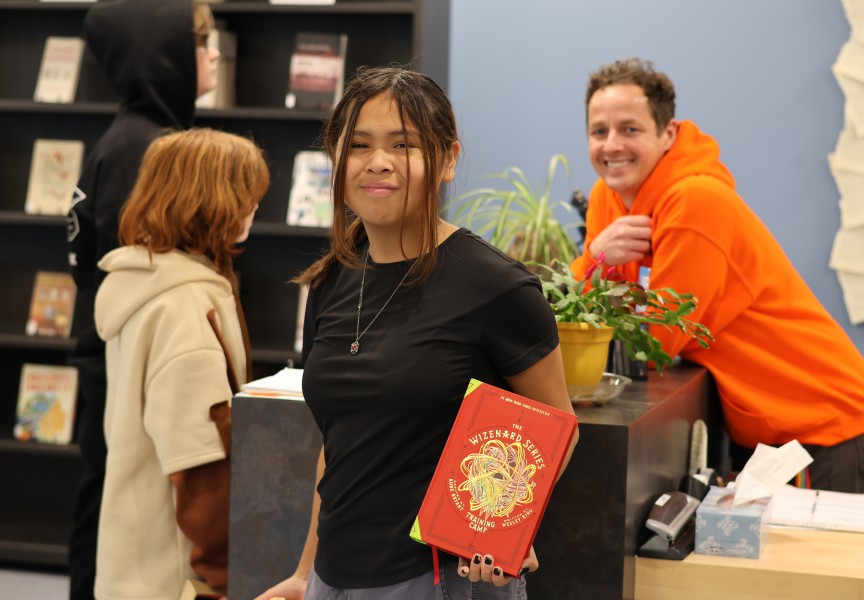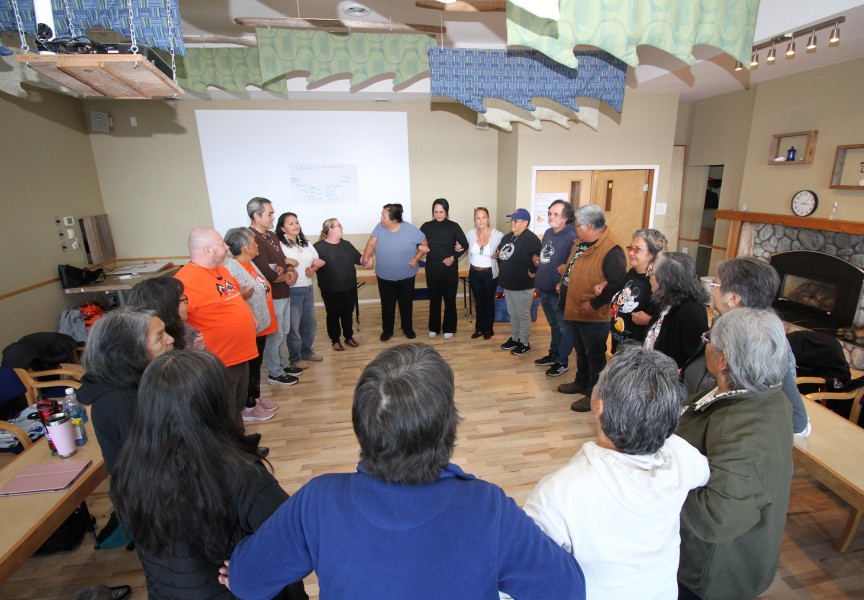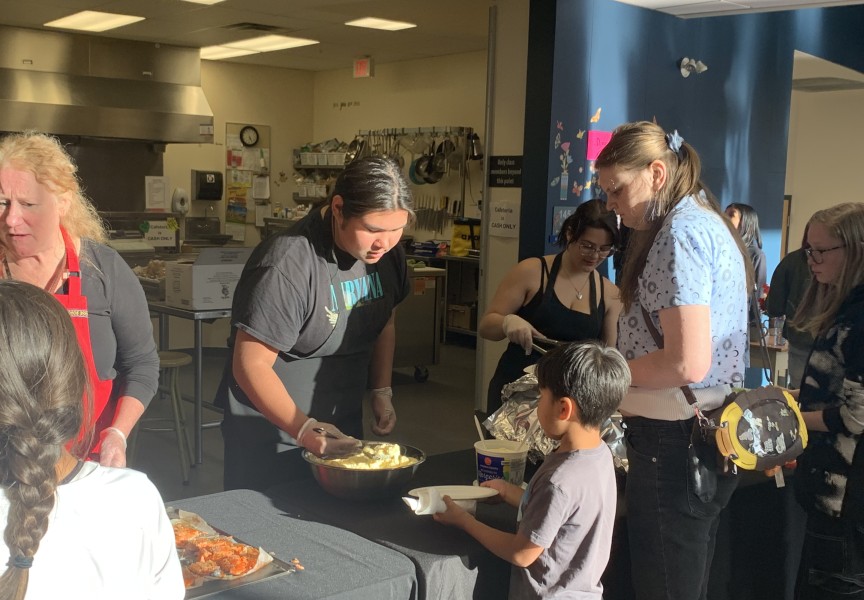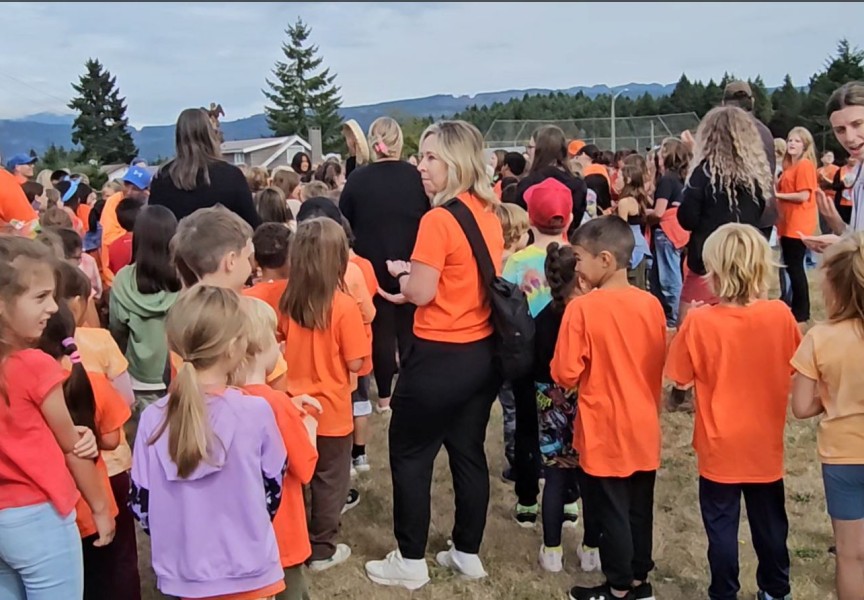Amid a growing number of Aboriginal students earning their secondary diploma, this month Nuu-chah-nulth-aht are celebrating a generational shift towards formal education – a development that elders see as strides ahead of their residential school past.
“We’re our ancestors wildest dreams,” said Damon Rampanen, a cultural support worker at Alberni District Secondary, during a two-day celebration of graduates and scholarship winners that was held at the high school June 6 and 7.
To start proceedings on each of those days Rampanen performed the Equality Song on the stage with a group of students, a piece that he explained was composed by Patrick Aleck during the COVID-19 pandemic. While Nuu-chah-nulth people were prevented from gathering, Aleck created the song as a piece belonging to everyone, including non-Indigenous people.
“This is how our ancestors wanted to see us; celebrating our culture, but also getting an education,” said Rampanen before the crowd. “We have a place in this work, and that’s exactly what that song is about.”
Hosted by the Nuu-chah-nulth Tribal Council, dozens of scholarships were awarded on June 6, ranging from Kindergarten to post-secondary studies. Then on the second day of proceedings 77 Nuu-chah-nulth high school and post-secondary graduates were recognized with their respective First Nations.
Announcer Tyson Touchie reflected on how things have changed since he graduated high school in 1989.
“I always felt like an alien in my own country going to school,” said Touchie, who works as a case manager with the Nuu-chah-nulth Employment and Training Program. “Fast forward to now, I go into that same school in Ucluelet and you’ll see house posts, Nuu-chah-nulth house posts carved by the students. Just like you see here with ADSS’s team names, their logo, integrating quu’aas culture. The step up that our kids know is a huge jump from where their grandparents came from.”
Not far from where the Alberni high school now stands, on the other side of the Somass River the Alberni Indian Residential School operated for nearly a century. That institution closed for good in 1974, but its legacy remains as a reminder of what several past generations of Nuu-chah-nulth-aht faced in school.
During the graduation ceremony former AIRS student Jeff Cook reflected on being forced to live away from his family for 10 months of the year.
“You’ve heard about residential school, I was there for 13 years, and it was tough,” said the Huu-ay-aht elder. “I acknowledge the educators today and the parents today that bring up their children, that they didn’t have to do the struggles that a lot of our people did. I acknowledge how you take care of them, how you look after them, how you cherish them and how you support them, which was something that we never got in residential school.”
Rising graduation rates
Two generations after the segregation of the residential school system, First Nations now comprise a significant portion of public schools on western Vancouver Island – and a growing number are finishing Grade 12. Thirty-seven per cent of the Pacific Rim School District currently identifies as Indigenous. Back in 2010, just 34 per cent of SD70’s Aboriginal students completed high school within six years of starting Grade 8 – thirty points behind other students in the district at the time. But by 2024 the Indigenous high school completion rate had risen to 81 per cent, while other Pacific Rim students increased to 90.
Further north on the coast, the most recent numbers from School District 84 are even more encouraging. Last year 87 per cent of SD84’s Indigenous students finished high school within six years of starting Grade 8, while others in the district tracked a completion rate of 75 per cent. Comprising schools in Gold River, Tahsis, Zeballos and Kyuquot, most of the district’s students this year – 193 out of 318 – identify as Indigenous.
As he awaits retirement this summer, SD84 Superintendent Lawrence Tarasoff reflects on the value of Nuu-chah-nulth students being taught by adults from their own communities. When he started in the district in 2008, he recalls that there weren’t any Nuu-chah-nulth teachers. Now there are seven out of the 30 working in SD84, thanks in part to an initiative that trains people to become teachers in remote communities without them having to relocate.
For Tarasoff, this made more sense than solely relying on educated outsiders to come teach in coastal communities with a large proportion of Indigenous students.
“The philosophy behind it was it’s a lot easier to teach people to be teachers, than it is to teach people to be able to be effective in Nuu-chah-nulth,” he said of the training initiative. “I was supportive, but it was really community that drove it forward.”
“They can stay home and do it, that was the philosophy. The outcome of that is that our kids are doing better, we can see it,” continued Tarasoff during the scholarship celebration at ADSS on June 6. “The young people of today, they can become teachers, and they can become teachers at home. Staying at home, being the leaders of their communities teaching the kids.”
In recent years SD84’s schools have taken turns hosting a cultural celebration near the end of each school year. In May it was Zeballos Elementary Secondary’s turn, and it held a potlatch that brought hundreds to the village, an event that began with giving Nuu-chah-nulth names to every child in the school.
‘You have every right to be competitive’
Amid these efforts to integrate more First Nations culture into the educational environment, most students appear to be feeling at home in school. A learning survey tracked by the B.C. Ministry of Education over 2023-24 found that 67 per cent of SD84’s Indigenous elementary students felt welcome at their school, while 57 per cent of the district’s overall primary student body reported this sense of belonging.
Over the same school year, a similar survey taken in the Pacific Rim district found that 64 per cent of the Indigenous elementary students felt welcome at school, part of an overall rate of 69 per cent among the primary grades. The district reported similar results with its high schoolers, coming in at 65 and 71 per cent for Indigenous and the total student body respectively.
While encouragement can be found in these surveys that gauge student satisfaction and wellness, there appears to still be significant gaps in the standardized skills assessments that are given to students in Grades 4, 7, 10 and 12. During this school year in SD84 Indigenous students scored up to 20 per cent lower than the district’s overall results from some literacy and numeracy categories, while Pacific Rim also saw its Aboriginal students score lower from these provincial assessments.
From the current school year, Pacific Rim’s Grade 4 literacy test found that 55 per cent of students were “on track or extending” for their age level, but just 34 per cent of the district’s Indigenous youngsters were at this level. Numbers were similar for the numeracy assessment, with 62 and 39 per cent respectively.
This gap was also present among Grade 10 students, with Indigenous learners tracking a 35 per cent rate compared to the 56 per cent overall “on-track” assessment for literacy, and numeracy coming in at 23 and 31 per cent for Aboriginal students and the total district.
During her valedictorian speech on June 7, Tia-Paige Watts reminded her fellow graduates that academics are only one part of getting through high school.
“High school was never just about textbooks and tests,” she said. “It was about showing up when we were tired, helping a friend through a rough day, and learning how to be ourselves – all while going through the challenges of becoming an adult.”
“If you have doors closed, kick them open, because you have every right to be competitive,” said Nuchatlaht elder Archie Little, who is also a survivor of the Christie Indian Residential School. “We were in a box in residential school, and we were never allowed to think outside that box.”







